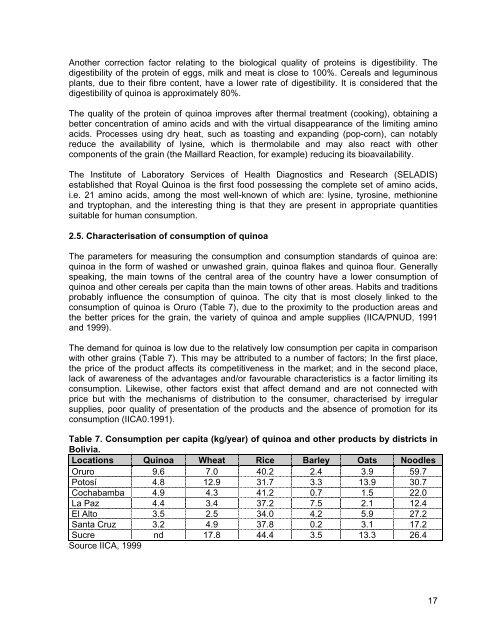Study on the social, environmental and economic impacts of quinoa ...
Study on the social, environmental and economic impacts of quinoa ...
Study on the social, environmental and economic impacts of quinoa ...
Create successful ePaper yourself
Turn your PDF publications into a flip-book with our unique Google optimized e-Paper software.
Ano<strong>the</strong>r correcti<strong>on</strong> factor relating to <strong>the</strong> biological quality <strong>of</strong> proteins is digestibility. The<br />
digestibility <strong>of</strong> <strong>the</strong> protein <strong>of</strong> eggs, milk <strong>and</strong> meat is close to 100%. Cereals <strong>and</strong> leguminous<br />
plants, due to <strong>the</strong>ir fibre c<strong>on</strong>tent, have a lower rate <strong>of</strong> digestibility. It is c<strong>on</strong>sidered that <strong>the</strong><br />
digestibility <strong>of</strong> <strong>quinoa</strong> is approximately 80%.<br />
The quality <strong>of</strong> <strong>the</strong> protein <strong>of</strong> <strong>quinoa</strong> improves after <strong>the</strong>rmal treatment (cooking), obtaining a<br />
better c<strong>on</strong>centrati<strong>on</strong> <strong>of</strong> amino acids <strong>and</strong> with <strong>the</strong> virtual disappearance <strong>of</strong> <strong>the</strong> limiting amino<br />
acids. Processes using dry heat, such as toasting <strong>and</strong> exp<strong>and</strong>ing (pop-corn), can notably<br />
reduce <strong>the</strong> availability <strong>of</strong> lysine, which is <strong>the</strong>rmolabile <strong>and</strong> may also react with o<strong>the</strong>r<br />
comp<strong>on</strong>ents <strong>of</strong> <strong>the</strong> grain (<strong>the</strong> Maillard Reacti<strong>on</strong>, for example) reducing its bioavailability.<br />
The Institute <strong>of</strong> Laboratory Services <strong>of</strong> Health Diagnostics <strong>and</strong> Research (SELADIS)<br />
established that Royal Quinoa is <strong>the</strong> first food possessing <strong>the</strong> complete set <strong>of</strong> amino acids,<br />
i.e. 21 amino acids, am<strong>on</strong>g <strong>the</strong> most well-known <strong>of</strong> which are: lysine, tyrosine, methi<strong>on</strong>ine<br />
<strong>and</strong> tryptophan, <strong>and</strong> <strong>the</strong> interesting thing is that <strong>the</strong>y are present in appropriate quantities<br />
suitable for human c<strong>on</strong>sumpti<strong>on</strong>.<br />
2.5. Characterisati<strong>on</strong> <strong>of</strong> c<strong>on</strong>sumpti<strong>on</strong> <strong>of</strong> <strong>quinoa</strong><br />
The parameters for measuring <strong>the</strong> c<strong>on</strong>sumpti<strong>on</strong> <strong>and</strong> c<strong>on</strong>sumpti<strong>on</strong> st<strong>and</strong>ards <strong>of</strong> <strong>quinoa</strong> are:<br />
<strong>quinoa</strong> in <strong>the</strong> form <strong>of</strong> washed or unwashed grain, <strong>quinoa</strong> flakes <strong>and</strong> <strong>quinoa</strong> flour. Generally<br />
speaking, <strong>the</strong> main towns <strong>of</strong> <strong>the</strong> central area <strong>of</strong> <strong>the</strong> country have a lower c<strong>on</strong>sumpti<strong>on</strong> <strong>of</strong><br />
<strong>quinoa</strong> <strong>and</strong> o<strong>the</strong>r cereals per capita than <strong>the</strong> main towns <strong>of</strong> o<strong>the</strong>r areas. Habits <strong>and</strong> traditi<strong>on</strong>s<br />
probably influence <strong>the</strong> c<strong>on</strong>sumpti<strong>on</strong> <strong>of</strong> <strong>quinoa</strong>. The city that is most closely linked to <strong>the</strong><br />
c<strong>on</strong>sumpti<strong>on</strong> <strong>of</strong> <strong>quinoa</strong> is Oruro (Table 7), due to <strong>the</strong> proximity to <strong>the</strong> producti<strong>on</strong> areas <strong>and</strong><br />
<strong>the</strong> better prices for <strong>the</strong> grain, <strong>the</strong> variety <strong>of</strong> <strong>quinoa</strong> <strong>and</strong> ample supplies (IICA/PNUD, 1991<br />
<strong>and</strong> 1999).<br />
The dem<strong>and</strong> for <strong>quinoa</strong> is low due to <strong>the</strong> relatively low c<strong>on</strong>sumpti<strong>on</strong> per capita in comparis<strong>on</strong><br />
with o<strong>the</strong>r grains (Table 7). This may be attributed to a number <strong>of</strong> factors; In <strong>the</strong> first place,<br />
<strong>the</strong> price <strong>of</strong> <strong>the</strong> product affects its competitiveness in <strong>the</strong> market; <strong>and</strong> in <strong>the</strong> sec<strong>on</strong>d place,<br />
lack <strong>of</strong> awareness <strong>of</strong> <strong>the</strong> advantages <strong>and</strong>/or favourable characteristics is a factor limiting its<br />
c<strong>on</strong>sumpti<strong>on</strong>. Likewise, o<strong>the</strong>r factors exist that affect dem<strong>and</strong> <strong>and</strong> are not c<strong>on</strong>nected with<br />
price but with <strong>the</strong> mechanisms <strong>of</strong> distributi<strong>on</strong> to <strong>the</strong> c<strong>on</strong>sumer, characterised by irregular<br />
supplies, poor quality <strong>of</strong> presentati<strong>on</strong> <strong>of</strong> <strong>the</strong> products <strong>and</strong> <strong>the</strong> absence <strong>of</strong> promoti<strong>on</strong> for its<br />
c<strong>on</strong>sumpti<strong>on</strong> (IICA0.1991).<br />
Table 7. C<strong>on</strong>sumpti<strong>on</strong> per capita (kg/year) <strong>of</strong> <strong>quinoa</strong> <strong>and</strong> o<strong>the</strong>r products by districts in<br />
Bolivia.<br />
Locati<strong>on</strong>s Quinoa Wheat Rice Barley Oats Noodles<br />
Oruro 9.6 7.0 40.2 2.4 3.9 59.7<br />
Potosí 4.8 12.9 31.7 3.3 13.9 30.7<br />
Cochabamba 4.9 4.3 41.2 0.7 1.5 22.0<br />
La Paz 4.4 3.4 37.2 7.5 2.1 12.4<br />
El Alto 3.5 2.5 34.0 4.2 5.9 27.2<br />
Santa Cruz 3.2 4.9 37.8 0.2 3.1 17.2<br />
Sucre nd 17.8 44.4 3.5 13.3 26.4<br />
Source IICA, 1999<br />
17

















